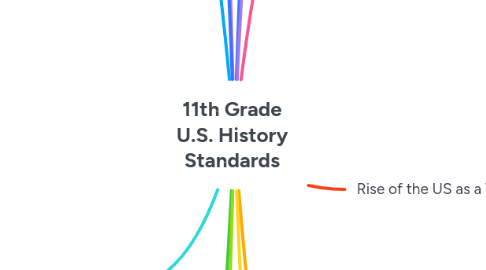
1. Activity #1
1.1. Simulation Day: Students are to pick an important character from the Great Depression. In costume and props, the student is supposed to tap into their historical character. They are to teach us about their character's life. And how their character was affected by the Great Depressions. (Teacher Guided)
1.1.1. Migrant Mother- Dorothea Lange.Click on Link to see the image
2. The Great Depression/ The New Deal
2.1. Why was there a Great Depression?
2.2. Discuss the human toll of the Depression, natural disasters, and unwise agricultural practices and their effects on the depopulation of rural regions and on political movements of the left and right, with particular attention to the Dust Bowl refugees and their social and economic impacts in California
2.3. How did the New Deal Attempt to remedy problems from the Great Depression?
2.4. Understand the explanations of the principal causes of the Great Depression and the steps taken by the Federal Reserve, Congress, and Presidents Herbert Hoover and Franklin Delano Roosevelt to combat the economic crisis.
2.5. How did ordinary people respond to the Great Depression?
3. World War II
3.1. Why did Americans not want to join WWII before the bombing at Pearl Harbor?
3.2. Analyze Roosevelt's foreign policy during WWII (Four Freedoms speech)
3.3. Discuss the constitutional issues and impact of events on the U.S. home front
3.3.1. Including the internment of Japanese Americans and the restrictions on German and Italian resident aliens; the response of the administration to Hitler's atrocities against Jews and other groups; the roles of women in military production; and the roles and growing political demands of African Americans
3.4. Discuss the decision to drop atomic bombs and the consequences of the decision (Hiroshima and Nagasaki)
3.5. How did WWII serve to advance movements for equality at home and abroad?
4. The Cold War
4.1. How did American foreign policy shift after WWII?
4.2. Why was the period between 1946 and 1990 known as the Cold War?
4.3. How did anti-communism drive foreign policy?
4.4. Trace the origins and geopolitical consequences (foreign and domestic) of the Cold War and containment policy
4.4.1. Era of McCarthysim, instances of domestic Communism. - Blacklisting
4.4.2. The Truman Doctrine
4.4.3. The Berlin Blockafe
4.5. Analyze the role of the Raegan administration and other factors in the victory of the West in the Cold War
5. Post- WWII
5.1. Studentss analyze the economic boom and social transgormation of post-World War II America
5.2. Describe the significance of Mexican immigration and its relationship to the agricultural economy, especially in California
5.3. Examine Truman's labor policy and congressional reaction to it
5.4. Analyze new federal government spending on defense, welfare, interest on the national debt, and federal and state spending on education, including the California Master Plan
5.5. Discuss forms of popular culture, with emphasis on their origins and geographic diffusion
5.5.1. Jazz and other forms of popular music, professional sports, architectural and artistic styles
5.6. Deescribe the increased powers of the presidency in response to the Great Depression, World War II, and the Cold War
6. Civil Right Movement
6.1. What were the goals and strategies of the Civil Rights Movement?
6.2. How was the govt involved in the Civil Rights Movement?
6.3. Examine and analyze the key events, policies, and court cases in the evolution of civil rights
6.3.1. Dred Scotts v. Sandford
6.3.2. Plessy v. Ferguson
6.3.3. Brown v. Board of Education
6.4. Examine the roles of civil rights advocates
6.4.1. Martin Luther King, Jr.
6.4.1.1. Activity # The significance of "Letter from Birmingham Jail" and "I have a dream" speech
6.4.2. Malcom X
6.4.3. Thurgood Marshall
6.4.4. Rosa Parks
7. Activity #2
7.1. Analyze Political Cartoon:Circle all of the hidden messages within the cartoon. Write a sentence response on why you circled that item.
7.1.1. "A Nauseating Job, But It Must Be Done" Political Cartoon. Click on Link to see political cartoon.
8. The Industrial Revolution
8.1. Who came to the United States at the end of the nineteenth and beginning of the twenntieth century? Why did they come? What was their experience like when they arrived?
8.2. Know the effects of industrialization on living and working conditions
8.2.1. Including the portrayal of working conditions and food safety in Uptron Sinclair's 'The Jungle'
8.2.1.1. The Jungle
